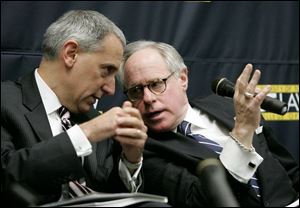
Chancellor visits UT to push plan for Ohio higher ed
6/18/2008
Eric Fingerhut, left, and James Tuschman confer during the UT forum that focused on a greater concentration on STEMM disciplines - science, technology, engineering, math, and medicine.
Ohio Board of Regents Chancellor Eric Fingerhut yesterday completed his state campus conversations tour with a panel at the University of Toledo.
The conversation focused primarily on the Centers of Excellence aspect of the chancellor's 10-year strategic plan that was given to the governor at the end of March and aims to raise Ohio's educational attainment.
Mr. Fingerhut said that colleges and universities play a key role in the state's economy by not only educating the work force, but also as a community force to help retain graduates and attract people to the area.
Having the state's 13 public universities designate Centers of Excellence, such as the photovoltaics work at UT, can help to reduce counterproductive competition and to focus on specific strengths.
"We can't all be focusing on the same things," Mr. Fingerhut said. "What this state needs is not 13 universities all doing the same thing. What this state needs is 13 universities each excelling in different and new areas of the global economy so the state can benefit from that set of programs."
Talks have focused on an increased concentration on STEMM disciplines - science, technology, engineering, math, and medicine - because Ohio has been lacking in those fields that are large economic drivers.
That focus has raised concerns at UT and other universities that the focus is taking away from liberal arts education.
"A good education surpasses STEMM," said Betsy Yeary, a junior theater major at UT who was a student representative on the panel. "I fear for the future of a well-rounded education at the University of Toledo and I don't feel that I am alone."
She said she took issue with UT President Dr. Lloyd Jacobs' remarks during his State of the University address in April that the Dell business model of mass customizing could be applied to higher education.
"We are not consumers shopping in an educational supermarket," she said. "We are here to develop independent ways of thinking."
Ms. Yeary's remarks had an impact on the rest of the discussion in which other panelists and members of the audience reiterated that a university should provide a quality, well-rounded education.
Mr. Fingerhut and fellow panelist Regent James Tuschman said there never has been the intention to improve STEMM education and allow other areas to diminish.
"I think reading into the initiatives that we are trying to create so we can compete in the world economy doesn't mean we exclude critical parts of higher education," Mr. Tuschman said.
"So I hope that you will all understand that when we talk about STEMM, it is not in a vacuum. It is part of the overall challenge we face in competing in the 21st century."
In addition to Mr. Fingerhut, Mr. Tuschman, and Ms. Yeary, the panel included Dr. Jacobs, Owens Community College President Christa Adams, state Rep. Peter Ujvagi (D., Toledo), state Sen. Mark Wagoner (R., Ottawa Hills), and Mike Betz, a UT alumnus and former student body president.
Contact Meghan Gilbert at:
mgilbert@theblade.com
or 419-724-6134.